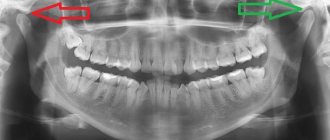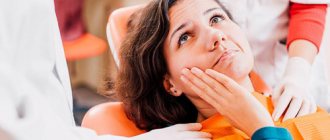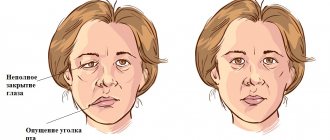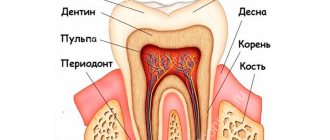A patient with neuritis of the facial nerve can be recognized immediately: squinted eyes, mouth, crooked smile, changes in facial expressions are immediately noticeable. However, the worst thing is that the time for treatment of facial neuritis is quite limited. If damaged nerves are not restored within several months, the chances of recovery are sharply reduced.
After about a year or two, you can only slightly reduce the pathological manifestations, but not completely get rid of them. After 5–10 years, all therapeutic measures will be aimed at at least partially restoring the functioning of the nerve endings. What do you need to know about the symptoms and treatment of inflammation of the facial nerve so as not to miss the deadline?
Concept of facial nerve neuritis
The main cause of a crooked smile is neuritis (inflammation) of the facial nerve. This is paresis, characterized by partial damage to the facial nerve with loss of certain functions. In severe cases, when the pathways of the nerves in the face are completely affected, we can talk about paralysis. Thus, this pathology is partial or complete damage to motor pathways from neurons located in the cerebral cortex to the end of the branches of the facial nerves with disruption of their functioning:
- facial expressions (smiling, raising eyebrows, wrinkling the nose or forehead, baring teeth, etc.);
- speeches;
- smell functions;
- closing eyes or blinking.
How to order services from the Ort-Artel clinic
Ort-Artel Dental Clinic is a Center for Comprehensive Dentistry, which uses a holistic approach to each patient in its work.
How is a holistic approach to treatment different? He assumes that the doctor knows how to identify cause-and-effect relationships in human physiology, and therefore treats not the symptoms of the disease, but its main cause. In dentistry, this approach makes the process of treating a patient more difficult for the doctor, but the result obtained is highly effective.
Location
The clinic is located at: Moscow, Mira Avenue, 75, building 1.
If you get there by metro, you need to get off at Rizhskaya station and after a 3-minute walk you will be at the door of the organization.
If you come to the clinic by car, then the definite advantages include the presence of your own free parking lot. The entrance to it is on the street. Trifonovskaya, the gate is located next to the pub. To be able to enter the parking lot, just call the security numbers listed on the official website.
Opening hours and contact methods
"Ort-Artel" is open from 9.00 to 21.00 daily. To make an appointment, just call the clinic at +7 (495) 128-11-74.
Or write by email, Viber or telegram network. Our managers will promptly respond to your message, and if there is such a need, they will forward your question to specialists.
You can also make an appointment by filling out a simple feedback form on the website https://www.ort-art.ru or order a call back by indicating a phone number. Our manager will immediately call you and answer all your questions, in addition, will help you decide on the choice of a specialist and his work schedule.
Our approach to treatment is based on the attention of the medical staff and their care for patients.
Facial nerve
The facial nerve is considered the main nerve of the human face. It comes to the surface in the area of the temporal bone and is divided into several branches:
- temporal;
- zygomatic;
- buccal;
- cervical and mandibular.
It performs mixed functions: provides secretion, movement, sensation (smell, taste). The facial nerve has a certain symmetry: thanks to it, both eyes close and open at the same time, both corners of the mouth are at the same height, when smiling they stretch symmetrically, when trying to raise the eyebrows they rise at the same height, and symmetrical folds form on the forehead.
Paresis or paralysis
When any part of the facial nerve is damaged, paresis or paralysis of a specific branch occurs - motor activity in this area is disrupted, and the patient cannot smile. His mouth begins to twist and his teeth on one side are not exposed when he smiles; one eye may not open. There may also be some disturbances in the functioning of the taste buds on the affected side. And salivation on this side, on the contrary, intensifies. This is how a crooked smile appears.
When the facial nerve is damaged, it usually becomes inflamed - when you palpate the affected cheek with your index finger and thumb, you will clearly feel the compaction of the branches of the nerves (you should palpate very carefully, as this causes pain to the person).
A smile will make everyone brighter, even if it is asymmetrical!
Tweet
Good afternoon
Today will be an unusual topic for many. Asymmetrical smile and what is attributed to it...
A sign of neuroticism, falsehood, crooked teeth or jaw, excessive sarcasm - this is what is most often attributed to people whose smile is asymmetrical. Is it so?
In fact, there is never complete symmetry in nature, and, as a rule, a person has one leg longer, one eye slightly larger, and a smile slightly shifted to one side. However, this “slightly” in most cases is not noticeable and becomes noticeable only upon closer examination.
Crooked teeth or jaws cause oral asymmetry, as do some muscle or nerve diseases, but these are physical nuances, and in this material we will focus on the psychological properties of an asymmetrical smile. Why do some people “squint” in one direction or another when they smile?
Many experts in the field of gesture and movement psychology, including the famous Paul Ekman, say that a fake smile is often asymmetrical. An ironic or sarcastic smile is often asymmetrical. This is all true, but not every person who smiles “unevenly” is lying to you. If people, whose even the most sincere and friendly smile is “shifted” only to one side (which, by the way, psychologists talk about, don’t judge by just one gesture, consider the behavior as a whole).
Some psychologists explain the asymmetry of a smile by the fact that one hemisphere reacts more emotionally and more vividly to what is happening than the other. Therefore, of those who “mow”, many “mow” to the left - the right hemisphere is generally more emotional (remember that the right hemisphere is responsible for the left side of the body, and vice versa, therefore in right-handed people the left hemisphere is more active). However, here is the time to remember the mentioned neuroticism - the fact that the hemispheres work so differently can cause other psychological disruptions that can lead to neuroses, and those to somatic or psychosomatic diseases. However, if you have an asymmetrical smile, you shouldn’t become a hypochondriac - this is just a general theory. After all, many children are born with asymmetry, or we are forced to wear plates for a long time.
Another reason is your subconscious reluctance to open up completely; you are always on guard, looking at the world through a visor. By the way, this same trait is associated with “accusations” that those with an asymmetrical smile are too ironic and even sarcastic. This is one of the methods of psychological defense - “translating” the arrows, banter, sometimes malicious.
But it is not all that bad. Owners of an asymmetrical smile are credited with more logical and rational thinking or, conversely, the ability to invent, imaginative thinking (depending on which hemisphere is more developed).
Be that as it may, an unnatural asymmetrical smile looks crooked and forced, but a natural one, even if it is asymmetrical, is beautiful and attracts people just as much as an “even” one. There is an opinion that, if you practice, you can, in principle, even out such a smile, although there is also a theory that asymmetry gives charm to its owners and owners.
Everything is relative, it is important to carry Love within yourself and look at the world through the prism of new times. Smile, there is always a reason to smile, because a smile charges us and guides us at the right moment in time!
Did you like the article? Click like below or go to the main page of the website “Live with Pleasure!”
Distortion on the face
The most characteristic external manifestation of this condition is a drooping and motionless corner of the mouth, a skewed eye, and a cheek. Moderate or profuse drooling and lacrimation on the affected side may also be observed. Moreover, the patient does not feel these nerves - he seems to forget how to wrinkle his nose, smile or raise an eyebrow. The muscle fibers on one side are immobile due to impaired nerve patency. Deterioration or complete loss of taste may also occur.
Causes of pathology
Scientists have still not been able to establish a definitive cause of this disease. A number of factors have been associated with facial nerve inflammation:
- Hypothermia, which leads to a decrease in the body's immune defense. In the case of neuritis, local hypothermia is especially dangerous. For example, a person was in a draft for a long time. In this case, spasm of blood vessels and muscles occurs, which causes disruption of nerve nutrition and the development of a crooked smile.
- A herpes virus that lives in the body of most people and does not manifest itself in any way. However, in case of decreased immunity, it actively multiplies in its favorite place - in the structures of nerve fibers. The virus causes nerve swelling and inflammation. It is believed that this pathology can also be provoked by polio viruses, mumps, enterovirus and adenoviruses.
- Taking large amounts of alcohol. Ethyl alcohol is a strong poison for the nervous system. It can affect not only the brain, but also cause inflammation of the facial nerves.
- High blood pressure. Hypertension can lead to increased intracranial pressure. In this case, the nuclei of the facial nerve are damaged. In addition, high blood pressure often causes stroke. And if the hemorrhage occurs near the facial nerve, then it also suffers.
- Pregnancy. The first trimester is especially dangerous. During this period, hormonal changes occur in the female body, which affect the nervous system.
- Brain tumor. This is a rare cause of neuritis, however, it should not be excluded. The tumor grows, pinches the nerve and disrupts the passage of nerve impulses.
- Traumatic brain or ear injuries. The blow causes damage or rupture of the nerve fiber. Fluid begins to accumulate in this area, swelling and inflammation occurs, which subsequently spreads to the entire nerve.
- Unsuccessful dental procedures, carious infection.
- Severe stress.
- Previous sinusitis and otitis. Pathologies of the ENT organs, bacterial or viral in nature, can spread to neighboring tissues or cause inflammation of the nerve in the area of the temporal bone.
- Diabetes. With this disease, metabolic disorders develop, which provokes the development of foci of inflammation.
- Atherosclerosis. The capillary vessels that supply the nerve with blood become clogged with plaque. As a result, the nerve begins to starve and its cells die.
- Multiple sclerosis. This disease is associated with the destruction of the myelin sheath of nerves and the formation of plaques. Such processes cause inflammation of the facial and optic nerves.
Why is the smile crooked? What is Bell's palsy?
Among the 14 pairs of cranial nerves that provide innervation and motor activity of various muscles of the head, neck and chest, 7 pairs are distinguished - the facial nerve, which branches into two symmetrical parts, left and right, respectively. The main function of the facial nerve is to innervate the facial muscles, lacrimal gland and part of the tongue. Due to an infectious lesion, pathological autoimmune processes or injury, the facial nerve temporarily loses its functionality, and a symptom complex called Bell's palsy occurs. The severity of symptoms depends on the level of compression of the facial nerve in the convoluted canal of the temporal bone, most often the cause is swelling. Nowadays, the main etiological factors for impaired conduction of nerve impulses in the facial nerve are considered to be: hypothermia, infectious diseases of nearby organs (otitis media - inflammation of the middle ear, mumps - inflammation of the salivary gland, meningitis - inflammation of the meninges, etc.), herpes virus, swelling due to a bruise or other type of injury, systemic diseases - diabetes and multiple sclerosis, immunodeficiency, severe intoxication, malignant tumors. In neurology, the causes of Bell's palsy have not been studied in detail, and there is no consensus regarding the age group at risk for this disease. Most experts insist that Bell's palsy is more common among people over 60 years of age, but there is no scientific basis for this fact. The main symptom of nerve damage is paresis and paralysis, in this case it is unilateral, rarely both parts of the face are affected. The asymmetry becomes quite pronounced: the edge of the eye droops, it becomes difficult or impossible for the patient to blink, the corner of the mouth droops (a symptom characteristic of the disease appears - a crooked smile), facial wrinkles gradually smooth out. Pathological changes in the sense organs appear: hearing impairment - an increase or decrease in auditory sensitivity, partial loss of taste or its distortion. Salivation and lacrimation may occur on the affected side of the face. There is a “sail sign” specific to Bell's palsy, which is the inability for the patient to puff out his cheek. The patient himself feels some numbness or heaviness on the affected side of the face. There may be pain in the area behind the ear. Another characteristic feature of the disease is an increase in the intensity of contraction of facial muscles on the healthy half of the face. This is nothing more than an attempt by the body to compensate in this way for the lost functions of the facial nerve. The development of pathological changes in Bell's palsy is rapid. The average speed of manifestation of the main symptoms varies within two to three days. There is a possibility that the symptoms of this pathology will disappear without specific therapy, however, the risk of relapse is also high. Complications characteristic of Bell's palsy are associated with the level of restoration of the conductive function of the facial nerve. A complete loss of contractility of the facial muscles is likely. Another complication of the disease is involuntary contraction of some facial muscles, even after remission. A consequence of impaired eye blinking may be a disruption in the process of complete hydration of the cornea, which can cause infection. Specific therapy for Bell's palsy is aimed primarily at diagnosing the root cause of the disease. To eliminate inflammation and swelling, which causes nerve compression, anti-inflammatory, vasodilator and antispasmodics are prescribed. For severe pain, analgesics are prescribed. In any course of the disease, it is necessary to coordinate treatment with a neurologist, and do not expect that the symptoms will disappear without a trace on their own; in addition, Bell's palsy may be a symptom of another organic pathology that requires urgent diagnosis and treatment.
Diagnostics
Establishing a diagnosis is quite simple - the patient has it “written all over his face.” The main external sign is an asymmetrical smile. However, for adequate therapy it is important to determine the location and extent of the lesion. Based on external signs, one can only guess which branches are affected, but this is not enough for a complete clinical picture.
For diagnosis, electroneuromyography is used, which allows one to evaluate the conductivity of nerve endings, track the signal path and find the affected area.
An MRI may also be ordered. The photographs show the affected nerves and surrounding tissues.
Treatment
People often ask: “What pills should I take if I have a crooked smile?” Let's figure it out.
Facial neuritis should be treated no later than 3 to 7 days from the onset of the first symptoms. This is because the disease progresses rapidly as nerve cells begin to die.
It is important to find out in advance how to correct a crooked smile.
For neuritis of the facial nerve, medications containing B vitamins are prescribed. This is a neurotropic combination that improves metabolic processes, trophism of nerve pathways, and impulse transmission. Lipoic acid (thioctacid) and the medicine Keltican are also prescribed.
To restore movement functions, the patient is prescribed a massage of the face and collar area, physical therapy, which is aimed at restoring blood supply to the affected nerves.
Smile as a diagnosis
And for those who didn’t have time for the broadcast, we choose the most interesting topics.
When it can become a symptom of serious diseases.
Stroke
What's on the face: a crooked smile - one corner of the mouth rises, and the other is motionless and even down.
Why it’s dangerous: facial asymmetry is a symptom of a stroke. During a stroke, one half of the face functions normally, but the other becomes immobile. If you suspect that a person has had a stroke, ask him to smile - this will allow you to quickly make a diagnosis and seek medical help in time.
In addition, the following may indicate that a person is having a stroke:
- loss of mobility of one arm - when a stroke develops, the muscle tone in one half of the body becomes so weak that the person cannot raise his arm;
- slurred speech coupled with facial asymmetry and loss of mobility in one arm.
What to do: If you suspect a person is having a stroke, ask them to say a phrase. If you hear unintelligible speech in response (“word salad”), urgently take the person to the hospital.
The clock is counting!
Parkinson's disease
What's on the face: a frozen mask - no sadness, no joy, zero emotions.
Why it's dangerous: a mask-like face is a symptom of Parkinson's disease. Parkinson's disease (shaking palsy) develops due to the death of nerve cells located in a small area of the brain - the substantia nigra. The death of these cells leads to a decrease in the amount of dopamine (transmits impulses for normal movements), disruption of normal nerve impulse transmission and the appearance of symptoms of Parkinson's disease, one of which is a mask-like face. In addition, stiffness in the legs when walking may indicate the presence of Parkinson's disease.
What to do: consult a doctor. He will prescribe drugs that increase dopamine levels. Parkinson's disease cannot be completely cured, but in modern conditions it can be controlled and the patient's quality of life can be improved.
Horner's syndrome
What's on the face: drooping eyelid on one side, the eyeball on this side is slightly sunken, and the pupil is narrow.
What is dangerous: unilateral ptosis (as drooping eyelids are called) can be a symptom of Horner's syndrome. Horner's syndrome is a complex multi-stage lesion of the oculomotor nerve, the manifestation of which is ptosis, a narrow pupil and the absence of tears. Horner's syndrome may be caused by a tumor in the upper lobe of the lung (Pancoast tumor).
What to do: An eye and lung examination is required.
About food
3 super soups
Which first courses are especially healthy?
1. Broccoli soup
Broccoli contains sulforaphane, a substance that protects against breast and colorectal cancer. Sulforaphane is not destroyed during heat treatment of broccoli.
The daily dose of broccoli soup is 150 g.
2. Tomato soup
Red tomatoes contain lycopene, a substance that protects men from prostate cancer. Heat treatment of tomatoes increases the amount of lycopene they contain. The daily dose of tomato soup is 200 g.
3. Pumpkin soup
Pumpkin contains beta-carotene (a precursor to vitamin A). Beta-carotene, once in the human body, is converted into vitamin A, which is involved in the synthesis of rhodopsin, the visual pigment of the retina. Vitamin A deficiency leads to impaired color perception and twilight vision.
The daily dose of pumpkin soup is 200 g.
Watch “Live Healthy!” from Mon. on Friday at 9.45 on Channel One.
Exercises
What exercises can be performed for inflammation of the facial nerve? How to correct a crooked smile with exercises?
It is necessary to force the nerve fibers to begin functioning again. To practice, you need to use a mirror, in front of which you do gymnastics: raising and lowering your eyebrows, blowing air through pursed lips, pronouncing sounds, syllables and words, trying not to twist your lips to one side.
We looked at the symptoms and treatment of inflammation of the facial nerve. For therapy to be effective, it is necessary to approach the process comprehensively. A variety of physiotherapeutic procedures that are aimed at eliminating the inflammatory process in nerve fibers and restoring their conductivity have a good effect.
Why do we smile?
Let's go back to 2022. Today, smiles are all around us - in the form of smiley faces, refrigerator magnets, advertisements, and even well-meaning strangers. Those who smile frequently are considered more likable, competent, approachable, friendly and attractive.
But the truth is much more sinister. Of the 19 different types of smiles, only 6 are associated with a truly good smile. The rest happen when we are hurt, uncomfortable, scared, sad or embarrassed. A smile can mean contempt, anger or mistrust, a lie or loss.
Of the 19 different types of smiles, only 6 are associated with a truly good smile.
While our genuine, happy smiles exist as a reward for having done something positive to support our existence, unhappy smiles have less to do with what you're experiencing internally and more to do with what you want to signal to others. “Some smiles have evolved to signal that we are cooperative and non-threatening; others have evolved to let people know, without aggression, that we are superior to them in our current situation,” says Paula Niedenthal, a psychologist at the University of Wisconsin-Madison.
Many of them are polite gestures that show that we are following the rules. But they can also be an effective way of manipulating others or distracting them from our true feelings. Most often, this universal symbol of happiness is used as a mask.









